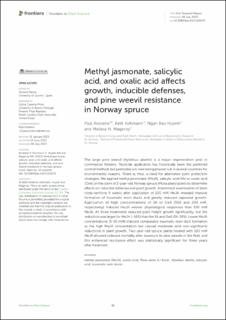| dc.contributor.author | Krokene, Paal | |
| dc.contributor.author | Kohmann, Ketil | |
| dc.contributor.author | Huynh, Ngan Bao | |
| dc.contributor.author | Magerøy, Melissa | |
| dc.date.accessioned | 2023-12-21T13:02:14Z | |
| dc.date.available | 2023-12-21T13:02:14Z | |
| dc.date.created | 2023-07-06T09:36:50Z | |
| dc.date.issued | 2023-07-06 | |
| dc.identifier.citation | Frontiers in Plant Science. 2023, 14 1-11. | en_US |
| dc.identifier.issn | 1664-462X | |
| dc.identifier.uri | https://hdl.handle.net/11250/3108613 | |
| dc.description.abstract | The large pine weevil (Hylobius abietis) is a major regeneration pest in commercial forestry. Pesticide application has historically been the preferred control method, but pesticides are now being phased out in several countries for environmental reasons. There is, thus, a need for alternative plant protection strategies. We applied methyl jasmonate (MeJA), salicylic acid (SA) or oxalic acid (OxA) on the stem of 2-year-old Norway spruce (Picea abies) plants to determine effects on inducible defenses and plant growth. Anatomical examination of stem cross-sections 9 weeks after application of 100 mM MeJA revealed massive formation of traumatic resin ducts and greatly reduced sapwood growth. Application of high concentrations of SA or OxA (500 and 200 mM, respectively) induced much weaker physiological responses than 100 mM MeJA. All three treatments reduced plant height growth significantly, but the reduction was larger for MeJA (~55%) than for SA and OxA (34-35%). Lower MeJA concentrations (5-50 mM) induced comparable traumatic resin duct formation as the high MeJA concentration but caused moderate (and non-significant) reductions in plant growth. Two-year-old spruce plants treated with 100 mM MeJA showed reduced mortality after exposure to pine weevils in the field, and this enhanced resistance-effect was statistically significant for three years after treatment. | en_US |
| dc.language.iso | eng | en_US |
| dc.publisher | Frontiers Media | en_US |
| dc.rights | Navngivelse 4.0 Internasjonal | * |
| dc.rights.uri | http://creativecommons.org/licenses/by/4.0/deed.no | * |
| dc.title | Methyl jasmonate, salicylic acid, and oxalic acid affects growth, inducible defenses, and pine weevil resistance in Norway spruce | en_US |
| dc.type | Peer reviewed | en_US |
| dc.type | Journal article | en_US |
| dc.description.version | publishedVersion | en_US |
| dc.rights.holder | © 2023 Krokene, Kohmann, Huynh and Mageroy | en_US |
| dc.source.volume | 14 | en_US |
| dc.source.journal | Frontiers in Plant Science | en_US |
| dc.identifier.doi | 10.3389/fpls.2023.1155170 | |
| dc.identifier.cristin | 2161139 | |
| dc.relation.project | Norges forskningsråd: 324129 | en_US |
| dc.relation.project | Norges forskningsråd: 325319 | en_US |
| dc.source.articlenumber | 1155170 | en_US |
| cristin.ispublished | true | |
| cristin.fulltext | original | |
| cristin.qualitycode | 2 | |

